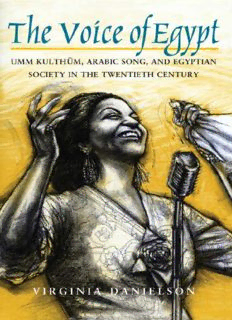
The Voice of Egypt: Umm Kulthum, Arabic Song, and Egyptian Society in the Twentieth Century PDF
Preview The Voice of Egypt: Umm Kulthum, Arabic Song, and Egyptian Society in the Twentieth Century
THE UNIVERSITY OF CHICAGO PRESS, CHICAGO 60637 THE AMERICAN UNIVERSITY IN CAIRO PRESS © 1997 by The University of Chicago All rights reserved. Published 1997 Printed in the United States of America 17 16 15 14 13 12 11 10 09 08 4 5 6 7 8 ISBN-13: 978-0-226-13608-0 (e-book) ISBN-10: 0-226-13612-4 (paper) Library of Congress Cataloging- in-Publication Data Danielson, Virginia The voice of Egypt : Umm Kulthūm, Arabic song, and Egyptian society in the twentieth century / Virginia Danielson. p. cm.—(Chicago studies in ethnomusicology) Includes bibliographical references (p.) and index. ISBN 0-226-13611-6.—ISBN 0-226-13612-4 (pbk.) 1. Umm Kulthūm, 1898-1975. 2. Singers—Egypt— Biography. 3. Songs, Arabic—Egypt—History and criticism. 4. Popular music—Egypt—History and criticism. 5. Music and society—Egypt. I. Title. II. Series. ML420.U46D36 1997 782.42163’092—dc21 96-45394 [B] CIP MN The paper used in this publication meets the minimum requirements of the American National Standard for Information Sciences—Permanence of Paper for Printed Library Materials, ANSI Z39.48-1992. VIRGINIA DANIELSON The Voice of Egypt UMM KULTHŪM, ARABIC SONG, AND EGYPTIAN SOCIETY IN THE TWENTIETH CENTURY CHICAGO STUDIES IN ETHNOMUSICOLOGY Edited by Philip V. Bohlman & Bruno Nettl EDITORIAL BOARD Margaret J. Kartomi Hiromi Lorraine Sakata Anthony Seeger Kay Kaufman Shelemay Bonnie C. Wade For Jim Contents PREFACE TECHNICAL NOTE 1 “THE VOICE AND FACE OF EGYPT” Some Questions Speech about Music Listening Performing “Popular” Music The Individual Social Issues 2 CHILDHOOD IN THE EGYPTIAN DELTA “Min al-Mashāyikh” Performing Experience The Audiences 3 BEGINNING IN CAIRO Music in Cairo The “Bedouin” Singer An Education in Music and Performance A Turning Point 1926 and Beyond 4 MEDIA, STYLE, AND IDIOM Taking a Direction in Style Producing Concerts Negotiating the Public Recordings and Radio Making Films Developing an Idiom 5 “THE GOLDEN AGE OF UMM KULTHŪM” AND TWO CULTURAL FORMATIONS The 1940s Musical Populism New Films Neoclassicism The Impact of the New Qaṣāʾid and the Populist Songs 6 “THE VOICE OF EGYPT”: THE ARTISTS’ WORK AND SHARED AESTHETICS Building the Model of the Song The Concerts “Her Voice … !” “But Can You Understand the Words?” “She Was Good Because She Could Read the Quʾrān” “She Gave Us Back the Qaṣīda” “She Never Sang a Line the Same Way Twice”. 7 UMM KULTHŪM AND A NEW GENERATION The National Songs and “Rābiʿa ʾl-ʿAdawiyya” “A New Stage” Collaboration with ʿAbd al-Wahhāb The Resilience of al-Sunbāṭī’s Songs The Ughniyya The Widening Market The Concerts for Egypt “The Fallaḥiin Are My Self” The Repertory Not Sung LEGACIES OF A PERFORMER GLOSSARY NOTES REFERENCES SOURCES FOR THE ILLUSTRATIONS INDEX Galleries of photographs Preface This book addresses the issue of agency in society, particularly the role of the exceptional individual in expressive culture. Theoretically, it rests on the rather large literature that has become known as practice theory as well as the literature associated with cultural studies. I am particularly indebted to the work of Raymond Williams, whose Culture and Society accounts successfully in broad social terms for a good number of English literary “stars.” My book draws from more than five years of fieldwork in several places in Egypt coupled with a reading of a substantial portion of the copious discourse on music and musicians in Egypt. Information has been readily available; however, answers to my questions are scattered throughout many sources and have been pieced together from literally hundreds of tiny announcements, short reviews, and interviews collected and evaluated over a period of years. I am grateful to the Fulbright-Hayes programs in Egypt, to a postdoctoral fellowship sponsored by the Rockefeller Foundation at the Institute for the Study of Religion, Literature, and Society in the Contemporary Middle East, University of Texas at Austin, and to the College Library at Harvard University for the years of support these institutions provided. The Douglas W. Bryant Fellowship at Harvard University underwrote the costs for obtaining rights and preparing illustrations. While in Egypt, I worked among musicians, “culture brokers,” and listeners from many walks of life in Cairo, Alexandria, and al-Minyā. I was particularly fortunate to have lived for two years in al-Minyā, for there I was led into more ordinary social circles than those in the cosmopolitan environment of Cairo and in the rather extraordinary world of musicians. My social role and obligations in al-Minyā were perhaps as normal as a foreigner can hope to have. In this environment I learned a great deal about Egyptian attitudes and values concerning expressive culture. Most academics benefit from the support of their colleagues, and I am particularly rich in this regard. Jihad Racy of the University of California-Los Angeles and Dr. Buthayna Farīd of the Institute for Music Education at Helwan University in Egypt helped me launch my research in Egypt and have remained
Description: